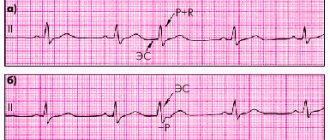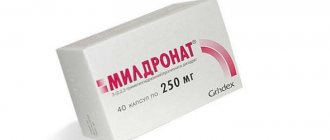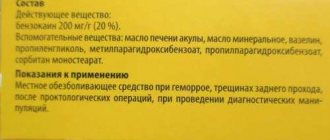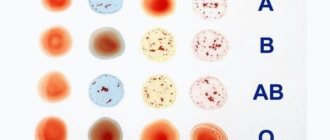ROE in the blood: what is this indicator?
ROE is one of the indicators in a general blood test that helps detect diseases of an inflammatory, infectious and autoimmune nature. Determines the erythrocyte sedimentation rate. The analysis is nonspecific, so deviations from the norm are possible even in healthy people.
During the treatment of certain diseases, it allows you to evaluate the effectiveness of the therapy.
Your doctor may order this test:
- For diagnostics and preventive examinations.
- When identifying inflammatory, infectious and autoimmune diseases.
- Assessment of the quality of treatment provided.
- To identify oncological processes in the body.
The material for analysis is blood from a vein and from a finger. The most accurate result is obtained by the Westergren testing method, when blood is taken from a vein and a more accurate scale is used to evaluate the result. By itself, ROE analysis will not be able to identify a specific disease, but together with other studies it is of great help in making an accurate diagnosis.
Erythrocyte sedimentation rate
What ROI in sales can be considered high?
Like any formula, ROI cannot be perceived abstractly in isolation from the situation. What is the purpose of the business? Get maximum profit. Most often, this can be achieved by selling all the goods or products that you have. The goal is achieved through the sale of goods or services.
Excellence in sales is difficult to achieve. As a rule, there is always room for growth: selling more and better. Many entrepreneurs choose the path of optimizing business processes without increasing the final cost of goods. They aim for ROI of 200%, 300% and even 400%. It is also important for companies to expand their markets. This process is characterized by large investments in advertising and a slight decrease in ROI.
Consider the following situation as an example:
| Product units sold, pcs. | Income, rub. | Expense, rub. | Profit, rub. | ROI, % | |
| Company 1 | 9 | 7 650 | 4 000 | 3 650 | 191 |
| Company 2 | 22 | 16 500 | 11 000 | 5 500 | 150 |
There are two companies. They sell the same product, for example, teapots. If you look at the data for the first company, they would seem to indicate its success and superiority over its competitor. However, the second company sold significantly more goods and its profits were higher.
Therefore, we can draw the following conclusion: if the coefficient value is negative, i.e. less than 100%, then this is definitely bad. If the ROI is more than 100%, then you need to analyze each specific situation. One of the scenarios is to increase the number of sales and income while reducing the ROI to 100%.
Applications from the site: how to increase the number and process them correctly
How to properly process applications from the site
More details
To clarify, let’s give the following example: a company at its maximum capacity can produce 50 pillows in a month, but it will not be able to sell that many. The products will remain in the warehouse and deteriorate. However, the company could spend part of the funds on advertising and promote its product until all 50 pillows are sold per month. At the same time, you need to ensure that the ROI is always greater than 100%. Once the maximum number of sales has been reached, you can start optimizing your advertising costs.
In short, you need to increase the investment until the maximum profit is obtained, provided that the ROI at all stages is above 100%.
Normal for women
The test is nonspecific and normal values are found in 95% of people. For an accurate diagnosis, it is used in conjunction with other indicators.
Roya's normal indicators are presented in the table:
| Age, years | Norm, mm/hour |
| Up to 13 | 43015 |
| Before 18 | 15-18 |
| Women | 42036 |
| After 50 | 15-20 |
According to sources of foreign literature, ROE is normal if it has indicators from 0-20 mm/hour. However, to accurately assess health, the doctor needs to know the woman’s age and the changes that occur in her body. If in children under 13 years of age the norm is a swarm indicator of 7-10, then during puberty it increases to 18 mm/hour.
In women, ROE should not exceed 15 mm/hour.
Sickle cell anemia ESR
When to calculate ROI?
You need to understand that ROI is a metric that directly indicates action. Such metrics are also called actionable metrics. There are metrics that you can look at and be happy or, on the contrary, be upset, but they do not show what exactly is wrong and what needs to be changed (for example, churn rate or the number of subscribers). Actionable metrics show exactly what needs to be changed.
ROI is not a conversion formula; it is not calculated in the background. ROI is calculated when some management decision needs to be made. For example, if you need to choose whether to purchase equipment or raw materials, remove or leave an advertising channel, kill the loyalty program or give it the right to exist.
When calculating, you need to take a period of time when nothing has changed globally in the advertising campaign, method of distribution or production.
Normal for men
Normal Roe indicators in men are somewhat different from those found in women, although the study is carried out in a similar way. In this analysis, the man’s age and the presence of chronic diseases play an important role.
Normal indicators can be seen in the table:
| Age, years | Norm, mm/hour |
| Infants | 43011 |
| Before 18 | 42005 |
| From 18 to 45 | 42949 |
| Up to 60 | To 10 |
| After 60 | Up to 15 |
Ideally, when interpreting analyses, the swarm should be in the range of 1-10 mm/hour. With age, the rate increases slightly, so after 60 years it is up to 15 mm/hour. Unfortunately, during tests, normal ROE values are observed too rarely due to the presence of various chronic diseases and inflammatory processes in the body.
Reasons for high ROE
An increased ROE does not always mean the presence of any pathologies in the body. If the indicators are elevated, it is necessary to exclude physiological causes of this phenomenon.
These include:
- Elderly age.
- Postpartum period.
- Menstruation.
- Puberty period.
- Pregnancy.
- State of stress.
- Taking estrogens and glucocorticoids.
About 5% of the world's inhabitants have abnormal ROE indicators from birth. Moreover, they do not have any chronic diseases or other pathologies that could contribute to this process. Why the analysis shows high numbers has not yet been established.
In other cases, it is important to contact your doctor, who will prescribe a number of additional tests for an accurate diagnosis.
An increased ROE is observed when:
- Inflammatory processes in the body.
- Infections.
- Serious lead or arsenic poisoning.
- After operations and other surgical interventions.
- With elevated cholesterol levels.
- Liver diseases.
- Anemia.
- Worm infestation.
- Significant blood loss.
- Hemolysis.
- Diabetes mellitus.
- Massive injuries and wounds.
- Hyperthyroidism or hypothyroidism.
- Kidney diseases.
Reasons for low ROE
It is necessary to show concern not only with high, but also with too low indicators.
Most often this occurs when:
- Muscle dystrophy.
- Presence of nervous disorders.
- Jaundice.
- Hepatitis.
- Cholecystitis.
- Circulatory failure.
- Leukemia.
- Fasting.
- Heart failure.
- Vegetarianism.
- Taking steroid hormones.
- Treatment with non-steroidal anti-inflammatory drugs.
ROE below 2 mm/h may indicate the presence of serious diseases. If it is slightly reduced, then it is necessary to change the diet and add iron and protein to it. Very often, this situation occurs in women who have lost weight dramatically and adhered to strict diets.
A decrease in erythrocyte sedimentation rate is extremely rare.
Increased swelling does not always mean that a person is sick and an inflammatory process is occurring in his body. In order to accurately decipher the analysis and understand why the ROE indicator is increased, you need to visit a specialist. Only with the help of additional tests and studies can an accurate diagnosis be made and the correct treatment prescribed.
Why is 5:1 a good ratio?
At a minimum, you must cover the cost of producing the product and the cost of selling it.
A 2:1 ROI is not profitable for many businesses, since the cost of producing or purchasing the product (also known as cost of goods sold, or COGS) is about 50% of the selling price.
If you spend $100 on marketing and another $100 on merchandise, making $200 in sales, you break even. If all you do with marketing is break even, don't do it.
Companies with higher margins need fewer sales, and companies with lower margins need to stretch their marketing spend before it becomes worth it. Their ratio should be higher.
Analysis of advertising channels, using end-to-end business analytics, can help identify ineffective advertising channels and disable them, thereby reducing the cost of sales.
What is ESR analysis and why is it performed?
ESR analysis is designed to determine the sedimentation rate of red blood cells - erythrocytes. When blood is taken for analysis, these bodies gradually begin to “stick together” and settle at the bottom of the tube. After 60 minutes, the sample separates into an almost transparent part on top and a dark, thick part on the bottom. The laboratory technician will enter the height of the transparent part in mm on the analysis form.
The condition, composition, level of viscosity and acidity of the blood have a direct impact on ESR indicators. According to the results of this study, it is possible to identify pathologies at the earliest stages, when external symptoms are almost invisible. ESR is a very sensitive indicator, almost irreplaceable in diagnosing diseases in newborns and infants.
The ESR norm for children of different ages in the table
ESR in children depends on how old the child is. It should be taken into account that the level of ESR in a teenager also depends on his gender. Minor deviations from the norm often indicate poor nutrition, stress or a mild cold. In general, it is believed that the greater the deviation and the higher the erythrocyte sedimentation rate, the more serious the disease.
Different sources offer different limit values for normal ESR values in children, the range may become wider as they grow older. The ESR norm for children from birth to adolescence is shown in the table below. It should be remembered that each child’s body is individual, and only the doctor can make final conclusions about deviations in value.
| Child's age | Floor | ESR norm, mm/hour |
| Newborns (up to 1 month) | M/F | 2-4 |
| Infants 1 – 12 months | 3-10 | |
| 1-5 years | 5-12 | |
| 6 – 14 years | 4-12 | |
| Over 14 years old | M | 1-10 |
| AND | 2-15 |
For example, if the ESR of a 2-year-old child is 10, this is normal. If, according to the test results, the erythrocyte sedimentation rate is 20, there is a reason to take the tests again and undergo a comprehensive examination to identify the pathological or physiological causes of such a significant deviation from the norm.
Methods for performing a blood test for ESR
For young children, the first method is preferable - it is based on the use of capillary blood and is the least traumatic of all.
If the baby has high ESR levels as a result of a blood test using the Panchenkov method, the doctor will give a referral for a Westergren test. This method is more accurate and is based on the use of the patient's venous blood and sodium citrate. For identifying diseases, this technique is considered the most reliable.
Useful tips
The fastest way to spend money is on live tennis at high odds. For example, it is good to bet on a tiebreak involving good tennis players during one of the sets. You can catch the winning game of the receiving tennis player on clay surfaces when two “players” meet.
In basketball, it is promising to bet on the underdog winning the quarter at odds higher than two. The probability of this event is usually higher than 50/50, so a flat or Kelly criterion is suitable, focusing on the statistics of previous meetings and the level of play of the opponents in the current match.
In football, it is profitable to play against a goal in one of the halves at odds higher than two. As a rule, most players bet on the opposite event in the hope of a successful game. The bookmaker is forced to increase the odds for the “Against a Goal” event. Therefore, it is profitable to bet on such a market during the game.
See also: Ballon d'Or footballers: world-class football stars with the title Player of the Year
In hockey, you can take a draw in flat periods or using the Kelly criterion. It is important to choose the most “drawn” clubs based on statistics. To determine the bet size, the bettor uses a calculator. In the “Your probability” field, you must enter the average percentage of draws in a certain period, as well as the odds and bank. As a result, the player receives the exact percentage of the coupon.
Thus, the combination of financial strategies with sports ones will allow the bettor to increase his ROI.
Factors influencing the ESR value in a child
ESR is a sensitive indicator that changes under the influence of many factors, both pathological and physiological. If a child has suffered from acute respiratory viral infection, his ESR value will be increased within 4-6 weeks after recovery. The following factors also influence the ESR value:
- increased physical activity;
- stressful situations;
- unbalanced diet;
- helminths;
- deficiency of vitamins and microelements;
- decrease or increase in the number of red blood cells;
- changes in blood viscosity or acidity;
- Times of Day;
- age (in children under one year of age, indicators are very different from normal for adults or adolescents);
- floor.
Test results are influenced by many factors, so doctors sometimes ask patients for a second blood donation.
Why is customer lifetime important when calculating ROI?
Lifetime value is the value that a customer brings to the business throughout his or her lifetime, not just from the first transaction. Many businesses only think about the cost of the first transaction and call it a day. But the customer's life can be much more fruitful for the company.
It's not uncommon for customers to return multiple times, usually from other advertising channels, and make additional purchases. The channel that first brought the client should have the greatest weight for calculating ROI; you need to continue to replenish advertising budgets for this advertising channel.
Because over time, the difference between primary costs and current costs will accumulate more and more, as demonstrated by one of these examples on the graph:
Costs have remained stagnant over time, but ROI has improved dramatically.
Why are the rates increasing and what diseases does this indicate?
An ESR value in a child’s blood exceeding 20 mm/hour (25, 30, 40 and above) indicates the development of a pathological process. Moreover, a value of 40 mm/hour is a sign of a serious illness that will require long-term treatment. An increased ESR in a child is more common than a decreased one. The indicator increases with the following diseases:
- pathologies of the liver, kidneys;
- large blood loss;
- hemoblastosis;
- leukemia;
- anemia;
- allergy;
- hyperthyroidism;
- hypothyroidism;
- diabetes;
- autoimmune diseases;
- connective tissue diseases;
- sepsis;
- cancer;
- tuberculosis;
- heart attack;
- infectious diseases;
- inflammation.
Deviation of the results from the norm indicates a pathological process, which one is determined by the attending physician.
To clarify the diagnosis, you will need to pay attention to other indicators, including the level of platelets and leukocytes. With oncology, anemia, rheumatic diseases or systematic overexertion, platelets will be increased. If platelets are low, this indicates a viral infection (eg, acute respiratory viral infection), hemophilia, or is the result of taking certain medications (see also: causes of low platelets in a newborn).
I calculated the ROI. What's next?
If we are talking about paid advertising, adjust advertising campaigns, disable ineffective ones, reduce or increase the advertising budget in order to expand the sales market without ineffective costs.
If we are talking about other expenses, analyze what can be used to increase efficiency or, conversely, what else is worth spending on.
Experiment. Test new ideas. Launch new campaigns. Correct your course as soon as you see that you are moving in the wrong direction.
The main value of ROI is that timely calculation of this formula allows you to make cheap mistakes. So make mistakes to learn and find the right path.
In what cases is increasing ESR considered safe?
An increase in the sedimentation rate of red blood cells is not always a consequence of diseases of internal organs or inflammatory processes in the child’s body. Sometimes we are talking about false positive test results. Non-pathological reasons that provoke an increase in ESR levels include:
- an abundance of fatty foods in the diet of a nursing mother (for breastfeeding babies);
- severe stress immediately before the collection of biomaterial (for example, if the child is afraid to take tests);
- teething (see also: can there be a cough when teething in children?);
- taking Paracetamol and its analogues (after using these medications, the test result will be unreliable);
- poor diet (lots of fatty, smoked and salty foods in the child’s diet);
- helminthic infestation;
- vitamin deficiency, hypovitaminosis, lack of nutrients.
During teething, ESR levels are usually elevated
Reasons for low values
If the erythrocyte sedimentation rate is significantly lower than normal, this often indicates dehydration (see also: normal erythrocyte count in urine in a child). The cause may be diarrhea, vomiting, hepatitis, epilepsy, blood diseases, and pathologies of the cardiovascular system. Sometimes breastfed babies don't get enough water at all - this is a common mistake that can also cause dehydration.
Reduced ESR levels are often observed in families that practice complete abstinence from animal foods. Another common cause of decreased red blood cell sedimentation rate is poisoning. You need to remember what the baby ate, check if he ate any medicines from the home medicine cabinet.
Low ESR values in the analysis may not be a consequence of the disease, but as a side effect of the treatment. Some medications have a strong effect on the reaction and composition of the blood of a child of any age (for example, calcium chloride or acetylsalicylic acid). The attending physician should warn parents about this effect.





